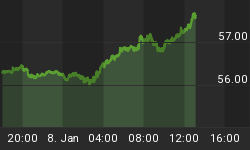Despite increasing noise in the main press about the rallying US stock market indices and a meaningless debate about the so-called "oil bubble," the most important event in May was arguably a breakdown in the prices of bonds along the entire maturity spectrum.
Shorter term bills and notes led the way and as a result, the yield curve flattened significantly.

The vast majority of market commentators interpret the breakdown in the US bonds as a bullish factor: money is flowing from bonds into stocks, from safe haven vehicles into riskier, growth oriented investments such as the Nasdaq 100 stocks. They reason that this means that an improvement in the economy is on the horizon.
We could have agreed with this conclusion if it was not for the mounting troubles in the financial sector, the main source of current economic and market problems.

The above chart shows that the Banking Index ($BKX) is continuing to severely underperform the S&P 500 Index. The latest decisive breakdown in the ratio of the two indices is related to the decrease in the spreads between the short term and the long term yields - a cushion in which banks make most of their profits (banks borrow short and lend long).

To make things worse, interest rate growth on the long term treasuries (10-yr & 30-yr) and relentless tightening of the lending standards is killing the barely breathing mortgage sector.
What conclusions can one draw from these developments? Despite all the efforts by the Federal Reserve over the last nine months, the monetary authorities have been unable to bring about substantial improvement in the financial sector of the US economy. This means that the worst in the economy is not yet over, especially if one recalls just a couple of important facts from a very long list of economic headwinds: (1) Gasoline and heating oil prices are at their all-time-highs, while (2) household debt is 85% higher than it was in 2001, the year we received our first rebate checks from the government.
Without a sizable improvement in the financial sector, we cannot envisage a sustainable rally in the US stock market. CNBC's latest headlines stating that - following two consecutive months of gains on all major stock indices, the worst for the economy is over - sound nothing more than the usual cheerleading.
In the midst of a widespread euphoria the media totally ignored the President of the Federal Reserve Bank of Dallas Richard W. Fisher's unusually candid remarks on Wednesday:
"... the Fed's dual mandate to manage growth and inflation. In the long run, growth cannot be sustained if markets are undermined by inflation. Stable prices go hand in hand with achieving sustainable economic growth. I have said many, many times that inflation is a sinister beast that, if uncaged, devours savings, erodes consumers' purchasing power, decimates returns on capital, undermines the reliability of financial accounting, distracts the attention of corporate management, undercuts employment growth and real wages, and debases the currency."
"Purging rampant inflation and a debased currency requires administering a harsh medicine. We have been there, and we know the cure that was wrought by the FOMC under Paul Volcker. Even the perception that the Fed is pursuing a cheap-money strategy to accommodate fiscal burdens, should it take root, is a paramount risk to the long-term welfare of the U.S. economy. The Federal Reserve will never let this happen. It is not an option. Ever. Period."
Rising interest rates, a breakdown in the financial stocks, and increasingly hawkish remarks by the voting member of the FOMC, spell trouble for the US stock market in 2008.
Implications for Gold
The chart below illustrates a hard-to-overlook correlation between the price of gold and the 30-year bond / 5-year note yield ratio. Last week, this ratio (which mirrors the flattening of the yield curve) made a decisive breakdown from a month-old support level. This has often been a bearish omen for gold.

Gold has not yet followed the ratio to the downside and remains in a short term uptrend. This marks a crucial divergence that will resolve itself in two ways over the next couple of weeks:
- The breakdown in the ratio turns out to be false, gold makes a successful retest of its prior low holding support of $850/oz;
- The breakdown in the ratio is for real; gold will head south, break through supports, settling in the lower 800s.
It is difficult to express preference for either scenario, but if we had to choose, we would favor the more bullish outcome due to a number of internal and sentiment indicators.

One thing is for sure: if gold closes below $850, the length of the gold and gold stock correction will be significantly increased although the downside should be limited to $800.
Despite our neutral short term outlook, we are seeing mounting evidence that in the next few months there will be an unexpected and dramatic rally in gold and gold stocks. Look for our future publications on this topic.
















